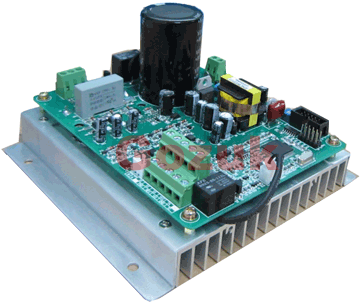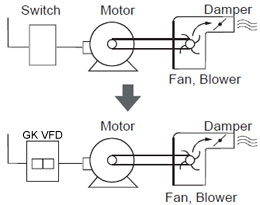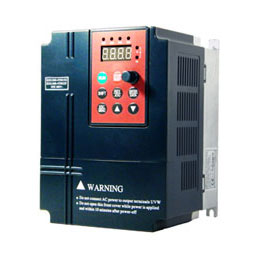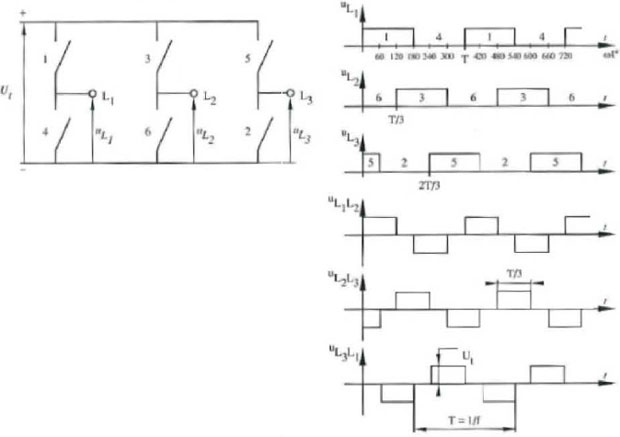Using VFD for pump application
We have a lot of issues with incoming supply for Electricity Board @ 360V which drops down to as low as 250V. In such cases, Irrigation Requirements come to stand still and hence want to provide them a solution of using VFDs for the pump, having Input 220V Single Phase AC and Output as 3Phase 220V AC delta connected Motor.
Will it work? Will it be suitable for pumping water, the torque requirements, etc.
Typically this type of variable frequency drive (VFD) is used for small scale applications where demand will be very low. Typically 220V single phase VFDs will be used on motor with a power rating of 1HP to 5HP this is enough to pump water from a well to a small reservoir but for more powerful motors it is best to stick with 3 phase. Your problem is difficult to solve with alternatives because electricity supply is the most critical part. Look at your motor power rating and then decide if this is going to work for you.
Based on my experience and knowledge I can say it is the best possible solution. To make it workable I suggest put single phase servo stabilizer of 3 to 5 kva rating with input ratio as per voltage availability in my case I have designed from 150 to 300 volts with output 230 to 240 volts .To output side of stabilizer put 1 phase input 3 phase output variable frequency drive of Gozuk make. The stabilizer may cost you around $.1000.
Will it work? Will it be suitable for pumping water, the torque requirements, etc.
Typically this type of variable frequency drive (VFD) is used for small scale applications where demand will be very low. Typically 220V single phase VFDs will be used on motor with a power rating of 1HP to 5HP this is enough to pump water from a well to a small reservoir but for more powerful motors it is best to stick with 3 phase. Your problem is difficult to solve with alternatives because electricity supply is the most critical part. Look at your motor power rating and then decide if this is going to work for you.
Based on my experience and knowledge I can say it is the best possible solution. To make it workable I suggest put single phase servo stabilizer of 3 to 5 kva rating with input ratio as per voltage availability in my case I have designed from 150 to 300 volts with output 230 to 240 volts .To output side of stabilizer put 1 phase input 3 phase output variable frequency drive of Gozuk make. The stabilizer may cost you around $.1000.
If you choose the right variable frequency drive with the ability to connect DC to the DC bus problem solved. I have done this in a particular industry segment.
I think the problem may be coming from your power distribution system.
How far from the power mains do your wires run? Are you using the correct wire gauge for less than 5% drop, for that distance? If you're close enough to your mains, and cable voltage drop is not the issue, another thing to check would be the power rating of your distribution transformer/substation, since a *huge* voltage drop like this usually means it's overloaded... try selecting a bigger VA rating transformer...
How far from the power mains do your wires run? Are you using the correct wire gauge for less than 5% drop, for that distance? If you're close enough to your mains, and cable voltage drop is not the issue, another thing to check would be the power rating of your distribution transformer/substation, since a *huge* voltage drop like this usually means it's overloaded... try selecting a bigger VA rating transformer...
i believe that vfd cannot solve your problem.it is the issue of power utility and proper voltage regulation.
Post a Comment:
You may also like:
Featured Articles
Non-Enclosure Variable Frequency Drive ...
 No enclosure (cover), reducing installation space and cost effective. Widely used in All-In-One control cabinet. Keep the same ...
No enclosure (cover), reducing installation space and cost effective. Widely used in All-In-One control cabinet. Keep the same ...
 No enclosure (cover), reducing installation space and cost effective. Widely used in All-In-One control cabinet. Keep the same ...
No enclosure (cover), reducing installation space and cost effective. Widely used in All-In-One control cabinet. Keep the same ...Variable frequency drive application ...
 Variable Frequency Drive (VFD) can be used in lots of fields. Variable frequency drives are widely used to control the speed of ...
Variable Frequency Drive (VFD) can be used in lots of fields. Variable frequency drives are widely used to control the speed of ...
 Variable Frequency Drive (VFD) can be used in lots of fields. Variable frequency drives are widely used to control the speed of ...
Variable Frequency Drive (VFD) can be used in lots of fields. Variable frequency drives are widely used to control the speed of ...Variable frequency drive in HVAC ...
 Variable frequency drives (VFD) have been used for HVAC systems in buildings for more than 40 years. But only in recent years, ...
Variable frequency drives (VFD) have been used for HVAC systems in buildings for more than 40 years. But only in recent years, ...
 Variable frequency drives (VFD) have been used for HVAC systems in buildings for more than 40 years. But only in recent years, ...
Variable frequency drives (VFD) have been used for HVAC systems in buildings for more than 40 years. But only in recent years, ...Variable Frequency Drive Harmonics and ...
A discussion of the benefits of variable frequency drives often leads to a question regarding electrical harmonic distortion ...
Three phase inverters
 In the variable frequency drive rectifier paper, it explains how to go from three phase alternating current voltage to a direct ...
In the variable frequency drive rectifier paper, it explains how to go from three phase alternating current voltage to a direct ...
 In the variable frequency drive rectifier paper, it explains how to go from three phase alternating current voltage to a direct ...
In the variable frequency drive rectifier paper, it explains how to go from three phase alternating current voltage to a direct ...
VFD manufacturers

Now the only question, what if the O/V release trips. Then the situation is helpless. That is pretty much acceptable. Because, I have been reported that the voltage drop from 360V to 250V is pretty constant for longer periods.
is then vfd-pump motor combination still recommended?